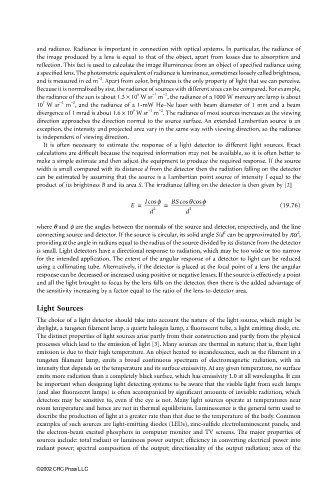Page 499 - The Mechatronics Handbook
P. 499
0066_frame_C19 Page 121 Wednesday, January 9, 2002 5:32 PM
and radiance. Radiance is important in connection with optical systems. In particular, the radiance of
the image produced by a lens is equal to that of the object, apart from losses due to absorption and
reflection. This fact is used to calculate the image illuminance from an object of specified radiance using
a specified lens. The photometric equivalent of radiance is luminance, sometimes loosely called brightness,
−2
and is measured in cd m . Apart from color, brightness is the only property of light that we can perceive.
Because it is normalized by size, the radiance of sources with different sizes can be compared. For example,
−1
−2
6
the radiance of the sun is about 1.3 × 10 W sr m , the radiance of a 1000 W mercury arc lamp is about
−1
7
−2
10 W sr m , and the radiance of a 1-mW He–Ne laser with beam diameter of 1 mm and a beam
−1
−2
9
divergence of 1 mrad is about 1.6 × 10 W sr m . The radiance of most sources increases as the viewing
direction approaches the direction normal to the source surface. An extended Lambertian source is an
exception, the intensity and projected area vary in the same way with viewing direction, so the radiance
is independent of viewing direction.
It is often necessary to estimate the response of a light detector to different light sources. Exact
calculations are difficult because the required information may not be available, so it is often better to
make a simple estimate and then adjust the equipment to produce the required response. If the source
width is small compared with its distance d from the detector then the radiation falling on the detector
can be estimated by assuming that the source is a Lambertian point source of intensity I equal to the
product of its brightness B and its area S. The irradiance falling on the detector is then given by [2]
Icos φ BScos θcos φ
E = -------------- = ------------------------------- (19.76)
2
2
d d
where θ and φ are the angles between the normals of the source and detector, respectively, and the line
2
connecting source and detector. If the source is circular, its solid angle S/d can be approximated by πα , 2
providing α the angle in radians equal to the radius of the source divided by its distance from the detector
is small. Light detectors have a directional response to radiation, which may be too wide or too narrow
for the intended application. The extent of the angular response of a detector to light can be reduced
using a collimating tube. Alternatively, if the detector is placed at the focal point of a lens the angular
response can be decreased or increased using positive or negative lenses. If the source is effectively a point
and all the light brought to focus by the lens falls on the detector, then there is the added advantage of
the sensitivity increasing by a factor equal to the ratio of the lens-to-detector area.
Light Sources
The choice of a light detector should take into account the nature of the light source, which might be
daylight, a tungsten filament lamp, a quartz halogen lamp, a fluorescent tube, a light emitting diode, etc.
The distinct properties of light sources arise partly from their construction and partly from the physical
processes which lead to the emission of light [3]. Many sources are thermal in nature; that is, their light
emission is due to their high temperature. An object heated to incandescence, such as the filament in a
tungsten filament lamp, emits a broad continuous spectrum of electromagnetic radiation, with an
intensity that depends on the temperature and its surface emissivity. At any given temperature, no surface
emits more radiation than a completely black surface, which has emissivity 1.0 at all wavelengths. It can
be important when designing light detecting systems to be aware that the visible light from such lamps
(and also fluorescent lamps) is often accompanied by significant amounts of invisible radiation, which
detectors may be sensitive to, even if the eye is not. Many light sources operate at temperatures near
room temperature and hence are not in thermal equilibrium. Luminescence is the general term used to
describe the production of light at a greater rate than that due to the temperature of the body. Common
examples of such sources are light-emitting diodes (LEDs), zinc-sulfide electroluminescent panels, and
the electron-beam excited phosphors in computer monitor and TV screens. The major properties of
sources include: total radiant or luminous power output; efficiency in converting electrical power into
radiant power; spectral composition of the output; directionality of the output radiation; area of the
©2002 CRC Press LLC

